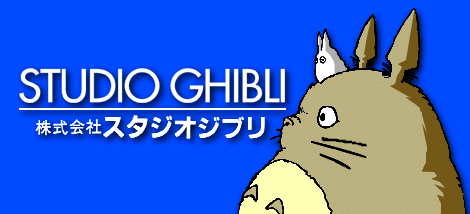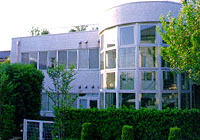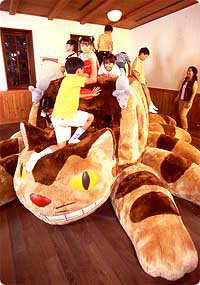Over the past couple of months I've been delving into the works of my favourite international movie house. And now in the final installment of the series I've decided to take a look at the company as a whole, where it is now and where it is headed in the future. But first, as with every story, we start at the beginning, its history.
Studio Ghibli was set up by Hayao Miyazaki and Toshio Suzuki, a now prolific producer at the Studio. Miyazaki had worked on a few projects with Isao Takahata, including Panda! Go Panda ! and Hols:Prince of the Sun. Its was Suzuki San however, who invited Takahata into the Ghibli stable. The name Ghibli came from Miyazaki's fascination with aviation. Ghibli was the name of a particular type of plane used in WW2. It means hot wind blowing through the Sahara desert. It was the Studio's intention to blow a wind of change into Japanese animation. according to Suzuki San.
In the early days the Studio hired no full time staff. The idea was that if one film was successful then another would be made but if one flopped that was it.
However, while Nausicaa and Laputa were major successes for the company, Totoro and Grave of the Fireflies were a theatrical flop. The Studio blames their release period for the flop. The Studio managed to stay afloat and two years later a rather unexpected event happened , Totoro merchandise began selling, and selling like hotcakes. The merchandise had been released not to promote the film's release which is unusual. The success ensured the company would never struggle financially again. Totoro also became the companies mascot at this time.
With Kiki becoming the highest grossing film in Japan in the year it was released ghibli had to decide how to run what was fast becoming a highly successful business. Full time staff was now hired and a training program for them was introduced. However, with these new innovations the company was faced with severely rising production costs. The studio had anticipated this and with the release of Only yesterday they started to really concern themselves with the advertising of their films in order to increase box office takings and offset production costs.
It also began to have a situation where films were constantly in production. Porco Rosso began production while Only Yesterday was still being produced. This meant that a stage came whereby all staff were put to work on Takahata's film which left Miyazaki totally on his own working on Porco Rosso for a time. He complained and was under stress but instead of focusing all his efforts on the task at hand he managed to somehow find the time to draw up a blueprint for a new studio for the company as well as gathering the materials for it and meeting with the builders to ensure the studio was as near to specified as possible. They had previously been working in a 300 metre-squared rented space. About a year later the studio was completed almost at the same time as Porco Rosso itself.
It was a great year for the company, Porco Rosso beat out "Hook" and Disney's "Beauty and the Beast" to become the highest grossing film of the year in Japan. Their new home was now Koganei a suburb of Tokyo. It now stretches over 1100 metres squared and over 4 floors. Also all animation work is done under one roof, a rarity in Japanese animation today.
In 1993 they made their first made for TV movie "Ocean Waves" which is currently unavailable in North America however, is widely available in Europe. Suzuki San claimed that the film achieved "satisfactory results". However, it is Ghibli's only TV movie.
Ghibli's efforts abroad initially were limited to the Asian region. Forgetting about the adaption of Nausicaa, the first release of a Ghibli film outside the region was Totoro by 20th century fox. It sold 560,000 copies. Pom Poko was even chosen as a best foreign film nominee at the academy awards. Spirited Away is the only non-English language film ever to have won a Best Animated film Oscar.The company also has a distribution deal with Walt Disney Pictures, which has seen them show many of the company's works play to various successes in the US. However, Studio Ghibli has said it will make films primarily for Japanese audiences and never cater for multi-national audiences in its marketing.
The Studio has always said it puts all its resources into its theatrical works, however it has made numerous shorts, TV commercials and even music videos. Most of its shorts are shown in the Ghibli Museum which opened in 2001 and was designed by Miyazaki himself. It is in the style of a hill top village in Italy and Miyazki wanted the Museum itself to be a feature. Inside is a homage to Ghibli, containing a model of the robot in Laputa and a giant catbus in which children can play.
So what lies in the future for Ghibli. Well its latest film The Borrower Arrietty was released in Japan this past July, directed by Hiromasa Yonebayashi, it would appear that with Goro and now Yonebayashi San the Studio is trying to pave the way for new young directors to take over from Takahata and Miyazaki. The studio as has plans to adapt the traditional Japanese folktale of the Bamboo Cutter into a film directed by Takahata who's genius has been sorely missed in the Studio's output of recent years. The Studio is also animating a game Ni no Kuni for the Nintendo DS which given both companies fame in the island nation is bound to be a massive hit.
It is scheduled for release on December 9th this year.
And that wraps up the first feature and longest post of Junction News. Thank you for sticking with me over the past number of weeks. If you have any comments about the feature leave them below. All criticism is welcome. Stay tuned to Junction News for all your news and media from across the globe.






No comments:
Post a Comment